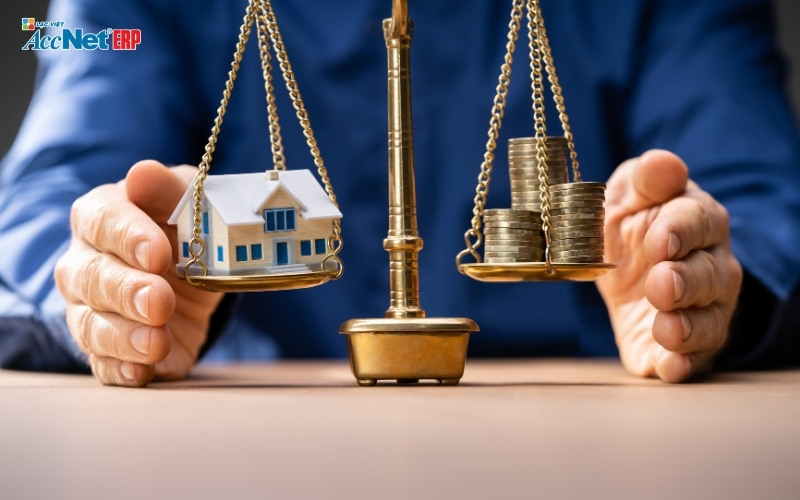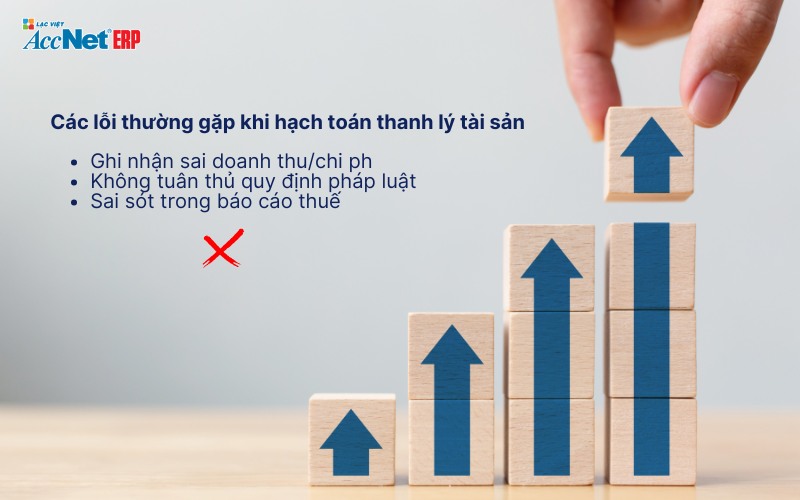When the property is no longer worth using, do not match the current demand, the liquidation of assets becomes necessary solutions. However, the process accounting for the liquidation of assets should be made standard. So, accounting for liquidation of fixed assets, what is done out why, how to optimize the liquidation of assets? This article AccNet will provide overview right here!
1. The concept of “accounting asset liquidation” what is it?
Accounting for liquidation of assets is the process of acknowledging, processing accounting transactions related to the sale, destruction, transfer of assets no longer in use value, no longer aligned with the business goals of the enterprise.
2. How to account/accounting liquidation of assets in business accounting
Before performing accounting, business need to accurately determine the residual value of the property to the basis of calculation: the value remaining = Original price of the property - value've accumulated depreciation
This value will be used to compare with the value obtained from liquidation in order to determine revenue, cost, profit (or loss) from trading.
2.1. Accounting recognize revenue from the sale and liquidation of fixed assets
Revenue from liquidation of assets is recorded in the account 711 - other income, if any, arise.
- Debt TK 111/112/131: proceeds from liquidation of assets (by payment method).
- Have TK 711: revenue from liquidation of assets.
- Have TK 3331: VAT payable (if any).
2.2. Accounting recorded expenses incurred in the liquidation process
Costs such as transportation, dismantling, cost of selling the property will be recorded:
- Debt TK 811 - other Costs: Costs incurred when liquidation.
- Have TK 111/112: payment costs.
Read more:
- Báo cáo ghi giảm tài sản cố định cần thiết khi kết thúc vòng đời sử dụng
- Quy trình thanh lý tài sản công hết hạn sử dụng áp dụng cho đơn vị hành chính
2.3. Accounting entries record the decrease in fixed assets were liquidated
Asset liquidation are reduced by the price, accumulated depreciation:
- Debt TK 214 - Depreciation of fixed assets: value accumulated depreciation.
- Debt TK 811: the residual value of the property (if there are holes).
- Have TK 211 - fixed Assets tangible: The price of the property.
2.4. Accounting recorded gain or loss from disposal of fixed assets
If interest:
- Debt TK 111/112/131: revenue from liquidation.
- Have TK 711: other income.
If the hole:
- Debt TK 811: Costs incurred or residual value exceeds revenue.
- Have TK 111/112/131: proceeds from liquidation.

2.5. Illustrative examples of accounting liquidation of fixed assets
Business A liquidation of a machinery and equipment:
- Original price: 800 million.
- Accumulated depreciation: $ 600 million.
- Residual value: 200 million.
- Sale price liquidation: 250 million (including VAT 10%).
- Shipping cost: 20 million.
Step 1: accounting revenue recognition liquidation
- Debt TK 111: 250 million.
- Have TK 711: 227,27 million (revenues excluding VAT).
- Have TK 3331: 22,73 million (VAT).
Step 2: accounting record the decrease in fixed assets after liquidation
- Debt TK 214: 600 million.
- Debt TK 811: 200 million (residual value).
- Have TK 211: 800 million (Original price).
Step 3: The account recorded shipping costs
- Debt TK 811: 20 million.
- Have TK 111: 20 million.
Step 4: Calculate interest from liquidation of assets
- Revenue: 227,27 million.
- Cost: 200 million (residual value) + 20 million (shipping Cost) = 220 million.
- Interest from liquidation: 227,27 million - 220 million = 7,27 million.

3. Legal regulations related to accounting asset liquidation business
3.1. The legal grounds for the accounting liquidation of assets
Liquidation of assets must comply with the legal regulations, accounting, tax in Vietnam, including:
- Circular no. 200/2014/TT-BTC: manual mode business accounting rules detail how to record transactions related to fixed assets.
- Circular 45/2013/TT-BTC: Quy định về chế độ quản lý, sử dụng, trích khấu hao tài sản cố định.
- The law on tax Administration: Regulations on value added tax (VAT), corporate income tax (CIT) arising from the liquidation of assets.
3.2. The common errors when accounting for liquidation of assets
- Recorded false, revenue/cost: Do not accurately determine the residual value of the property, not recording enough of the costs incurred.
- Failure to comply with the law: the Lack of inspection, no VAT invoice when selling the property.
- Errors in tax reporting: do Not fully recognize the obligation VAT, corporate INCOME tax from activities liquidation.

4. Applied software solutions for the account liquidation of assets
Sử dụng các phần mềm AccNet Asset giúp doanh nghiệp tối ưu hóa quy trình hạch toán thanh lý tài sản. Những tính năng nổi bật của phần mềm bao gồm:
- Automatically calculates the remaining value of the property based on historical cost, less accumulated depreciation.
- Provide transparent reporting on revenue, expenses, profit/loss from operations liquidation.
- Revenue recognition, cost accounting, profit/loss with just a few simple taps.
SOFTWARE ACCNET ASSET – STOP WASTING ASSETS
- Cut reduction by 15-20% repair costs each year thanks to proper maintenance term
- 50% discount time inventory, and reporting of property
- Avoid losses hundreds of millions of since the property is "missing the mark", using the wrong purpose
- Increase asset life cycle up minimum 25% thanks to the tracking and timely warning
- Reduce errors depreciation – is not tax arrears
A business average savings from 300 to 500 million/year after deployment AccNet Asset

SIGN UP CONSULTATION AND DEMO TODAY
Bài viết này không chỉ giúp doanh nghiệp hiểu rõ quy trình hạch toán thanh lý tài sản mà còn đưa ra các giải pháp thực tế để áp dụng cho doanh nghiệp. Hãy thử nghiệm ngay các giải pháp phần mềm AccNet Asset để quản lý tài sản, hạch toán thanh lý hiệu quả ngay hôm nay!
CONTACT INFORMATION:- ACCOUNTING SOLUTIONS COMPREHENSIVE ACCNET
- 🏢 Head office: 23 Nguyen Thi huynh, Ward 8, Phu Nhuan District, ho chi minh CITY.CITY
- ☎️ Hotline: 0901 555 063
- 📧 Email: accnet@lacviet.com.vn
- 🌐 Website: https://accnet.vn/

Theme: